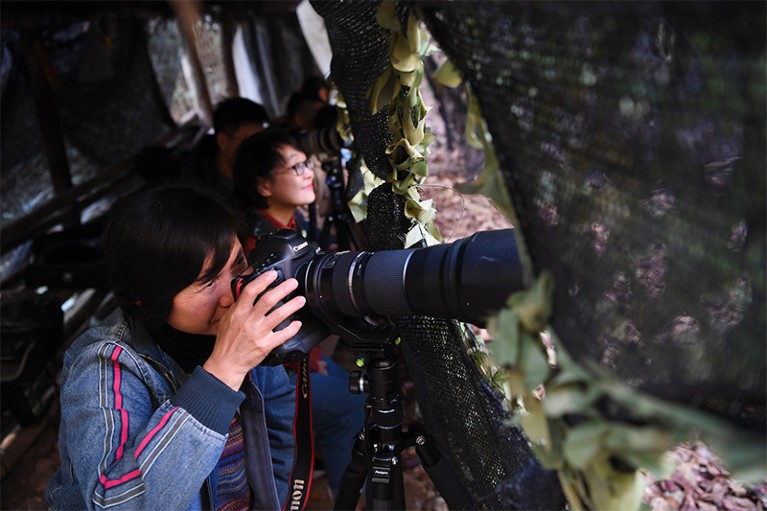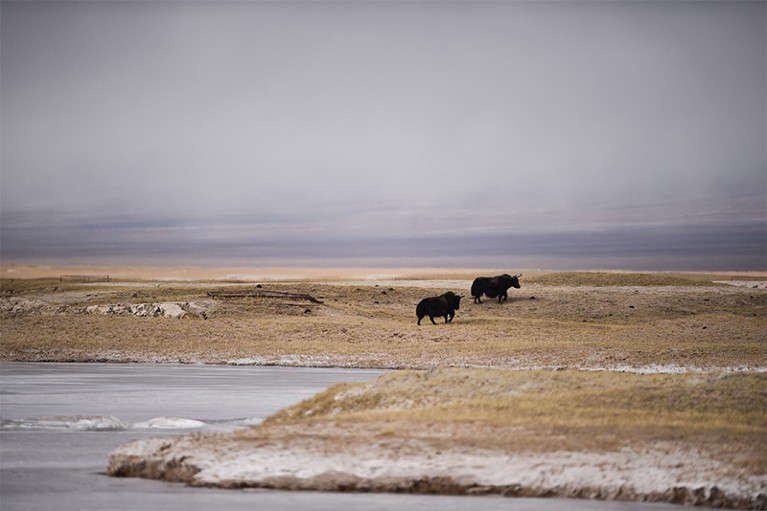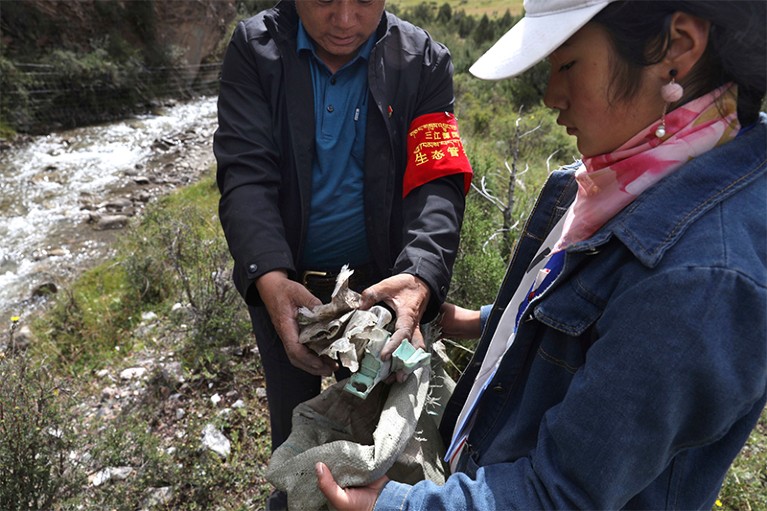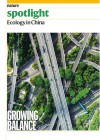
Tourists take photos at a bird-observation ecotourism point in Ziyun Village, in southeast China’s Fujian province.Credit: Xinhua/Shutterstock
Later this year, China will announce the first parks to be included in its new protected-areas system. It is aiming to replace the current fragmented network of poorly managed protected areas with a national-park model similar to that in other nations.
Since the idea was mooted in 2013, the Chinese government has drawn on expertise from around the world and set up ten pilot national parks to test specific conservation strategies.
Yet, millions of people work in and around these areas, doing everything from farming to running hotels. And once the parks receive formal protection, there will be a much smaller window for commercial activities and these people risk losing their livelihoods, says Rose Niu, chief conservation officer at the Paulson Institute in Washington DC. For the plan to succeed, China’s National Forestry and Grassland Administration will need to achieve a balance between protecting the country’s ecological systems and its people, Niu says. Her team has been closely involved in the plan’s development: advising on policy planning, training and the sharing of information between Chinese and international experts.
Proposed ideas to tackle the loss in earnings that local people could face include compensation schemes and the resettling of households. Jobs will also be created in park management and protection and in ecotourism to encourage residents to be employed as part of conservation efforts.
Niu thinks that encouraging local people to embrace this new economy, which also includes jobs in organic farming and wildlife management, is a very ambitious goal. “People’s awareness of these ideas is, sorry to say, still not very high. So you have to develop very strict rules for planning and management, so any ecotourism doesn’t get out of control. This can happen quickly, because it’s such a lucrative area and China has a highly entrepreneurial culture.”
People, protected areas and China
Economic development and environmental protection have a complicated history in China, born of the competing needs of boosting rural economies and conserving their natural resources. Short-term, profit-oriented projects have often won out.
For example, Jiuzhaigou, a biodiverse and famously scenic valley in Sichuan province, was designated a nature reserve in 1982 because of its endangered plants and animals, including giant pandas. Poorly managed tourism followed and the local economy boomed, but the reserve declined. A sharp rise in air and water pollution led to the removal of private transport and the closure of hotels and restaurants in the reserve at the end of 2004.
However, simply suspending tourism projects to regain control over the environment has an immediate knock-on effect for local residents, says Linjing Ren, a public-policy researcher at Northwestern Polytechnical University in Xi’an, China. “Many rely on offering accommodation and catering services for tourists, and can suddenly lose their main source of income,” she says.

Wild yaks navigate the Sanjiangyuan region of northwest China’s Qinghai province. The number of wild animals in the area is on the rise.Credit: CHINE NOUVELLE/SIPA/Shutterstock
And despite government efforts, protected areas continue to be exploited for commercial use. As recently as 2016, officials from five provinces were disciplined for allowing environmental regulations to be flouted. Their misdemeanours included allowing the discharge of untreated waste water into rivers and the mining of coal.
Having agricultural areas inside protected regions can also lead to conflict between people and wildlife. In the Qinling Mountains in central China, for example, the establishment of a nature reserve increased the numbers of animals such as bears and wild boar that eat and damage crops. Unfortunately, the government’s financial compensation scheme does not completely cover such losses, according to Yali Wen, a researcher at Beijing Forestry University who specializes in economics and the environment.
“One thing that could be improved is more government funding for human and wildlife conflicts. Not only is this fair, but it gives communities an incentive to engage with the idea that natural resources need to be protected in the long term,” Wen says.
New parks, new ecotourism
The need for a strategic approach to ensure the economic security of communities affected by the plan is urgent, given that four of the ten pilot parks are in western and central China, which contain the country’s poorest regions. The Giant Panda National Park, for instance — a 27,133-square-kilometre wildlife corridor in central China — encompasses impoverished areas in Sichuan, Shaanxi and Gansu provinces. And most of the 17,000 households who live inside the largest pilot park, 123,100-square-kilometre Sanjiangyuan in the northwest of Qinghai, make their living by yak herding. Many have collective land rights, which allow them to use the land for grazing, says Lu Zhi, a conservation biologist at Peking University in Beijing.

Bee hives, tended by local villagers, adorn cliffs in Guanba. The hives are in a community-conserved conservation area that also includes panda and otter habitats.Credit: Lu Zhi
But instead of paying compensation to local communities to convert swathes of land from grazing to parkland — an expensive exercise — the government decided to recruit one person from each household to retrain as a park ranger. According to Niu, who evaluated the retraining scheme in 2019, each community ranger is paid 20,000 yuan (US$3,100) per year to monitor wildlife and protect the local environment. This alternative livelihood makes them less dependent on the park’s natural resources, she says. “The herders said that although that salary is not a lot of money — it’s roughly the price of three yaks — they were very proud to be doing this work. The project was well designed to give them a sense of ownership.”
Government statistics say that 17,211 herders have already been hired to monitor the conservation of grassland and wildlife and raise awareness of environmental laws.
New ideas in action
Terry Townshend, a wildlife conservationist and biodiversity adviser to Beijing’s government, has since 2017 been training yak herders in Qinghai in the kinds of skills that ecologists hope could be a model for sustainable development since 2017. In 2016, he met the official responsible for Zaduo, a county in Qinghai Province where snow leopards roam the valleys, at a wildlife-watching festival organized by the Shan Shui Conservation Centre, a Chinese non-profit body. After mentioning that snow-leopard tours had been popular and lucrative in other countries, Townshend was invited to write an ecotourism proposal for Zaduo. Three months later, his ideas were given the green light.
“There’s very little literature on doing anything like this,” says Townshend. “I think it’s the first of its kind in China. I made it up from scratch. I remember flying there, thinking, is this really going to work? Are we really going to get Tibetan herders to come to a classroom to do training?”

A-Ta, a Tibetan herder whose income largely comes from raising yaks and collecting caterpillar fungus, places debris in a bag as he leads his team of rubbish collectors in Sanjiangyuan.Credit: Ng Han Guan/AP/Shutterstock
Over 3 days, Townshend and other specialists gave 16 herders the skills they needed to host tourists and take them on tours of local wildlife spots — everything from cooking and basic first aid to animal tracking and identification. What was key to the project’s success, he says, was giving the community autonomy to make decisions. By 2019, the project had generated 1 million yuan in revenue. “They made all major calls, from pricing the tours to deciding the programme’s organizational structure, and all of the income stays with the households,” says Townshend. “The long-term advantage is that the risk of local people killing wildlife is reduced, because they now see these predators as assets. It also means that tourism is carefully managed and profits [are] divided entirely equally.”
Townshend says the project was fortunate to have the three key elements he thinks are required for success: abundant wildlife, an effective community structure that can cooperatively deal with issues as they arise and the full support of local government.
From working with other snow-leopard-tourism teams in Italy, India, Nepal, Sweden and Afghanistan, he has found that projects missing any one of those ingredients are likely to fail. “Often, if the project is not effectively managed, there can be a breakdown in social cohesion. Families end up competing, with some benefiting more than others, causing jealousy and negative behaviour,” he says.
The need for full community buy-in
In 2018, Wen and his team at Beijing Forestry University surveyed 1,270 households inside and adjacent to the mooted pilot Giant Panda National Park. Around one-fifth had chosen to participate in local ecotourism schemes, such as running farm tours, providing catering and accommodation and selling local products to tourists. And Wen’s team found that those that did were already in a better economic and social position than were those who declined1.
“The early adopters were those who could afford to take a risk. They were already financially secure, had some form of higher education and were well placed geographically to work with tourists,” says Wen, adding that successful ecotourism depends on the ability of participants to withstand the risks and difficulties common to starting a business.
“In China, this means having a combination of financial and social capital: enough money to provide a safety net and strong-enough community connections to ensure that you can get support when you need it,” he says. And ultimately, the tourists need to turn up: local government has to deliver a well-considered and managed plan to encourage tourism into the area, he says.
One challenge posed by bringing ecotourism into poor communities is that it has the potential to exacerbate existing social divisions. Wen’s survey participants complained that wealthy people in the area were better equipped to take advantage of the fresh economic opportunities. “They felt it resulted in a widening gap between rich and poor,” he says.
Yet, despite income disparities, and complaints about how tourists can be invasive, Wen says that overall attitudes towards ecotourism were extremely positive, with most locals agreeing that the advantages entirely outweighed the disadvantages. Many of the most attractive aspects of ecotourism stem from a shift in people’s daily priorities, his research suggests. As agriculture has become more mechanized and fewer family members are needed to tend small plots, young people head to the cities for work. Creating ecotourism business models gives them an economic incentive to stay, he says. “Generations of families like the idea of being able to stay together, and the projects also increase people’s sense of pride in their home towns.”
A chance for the next generation
Ecologists in China hope that future generations will develop and improve ecotourism projects in protected areas. Niu, who grew up in a remote area of China, says it is key that any change to a person’s way of life brought about by government policy is voluntary. “No one should be forced to move, for example. But if people who live in remote areas are willing to move to places where they can access better public services, like schooling for their children and health care for seniors, the relocation should not be criticized,” she says. “The government should also give people opportunities to take part in sustainable business such as ecotourism, so they don’t have to rely on the overuse of natural resources.”
Lu has spent more than a decade developing a community conservation programme in the village of Guanba, in a part of Sichuan province that is also home to pandas. The programme includes a social enterprise that sells local honey. She says it took many years for people in China to come to appreciate these kinds of ecological products and for a market to grow around it. And it’s still in its early stages of profitability.
As the programme slowly developed and overcame setbacks, the community began to think more deeply about how to protect its environment. Eventually, in 2015, it declared the forest land around Guanba a community conservation area. Now the village has three separate ventures, all owned by the community. They are run by young people who moved back to the area to be part of this work.
Lu is confident that the village will benefit from the involvement of that younger generation.
“We are ecologists,” she says. “We are not trained in business management. We need to train people to do both. And ensure they bring these projects to life in far less than a decade.”


 Biodiversity’s importance is growing in China’s urban agenda
Biodiversity’s importance is growing in China’s urban agenda
 Seeing biodiversity from a Chinese perspective
Seeing biodiversity from a Chinese perspective
 How to limit the ecological costs of urbanization in China
How to limit the ecological costs of urbanization in China
 Spotlight on Ecology in China
Spotlight on Ecology in China






